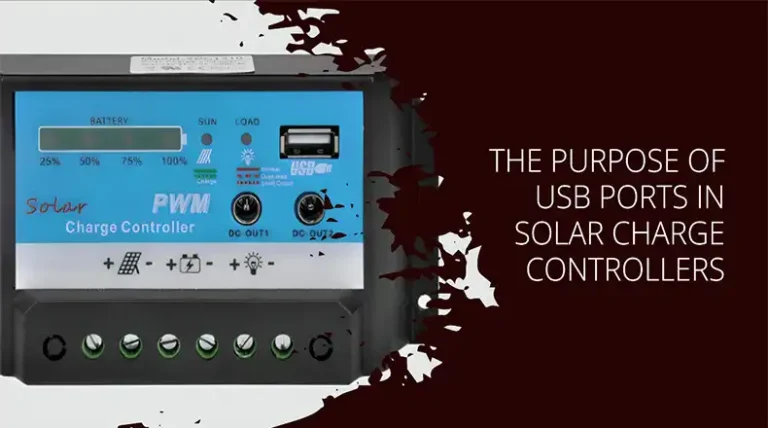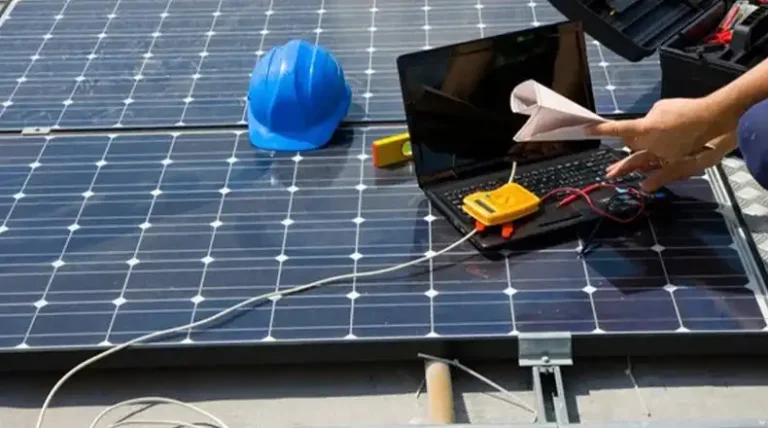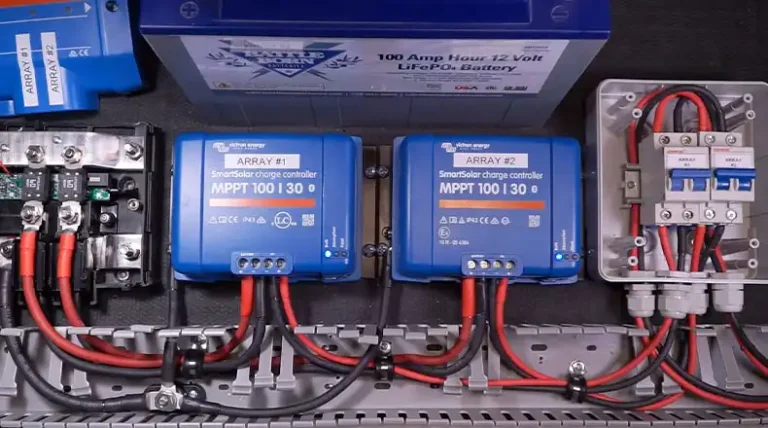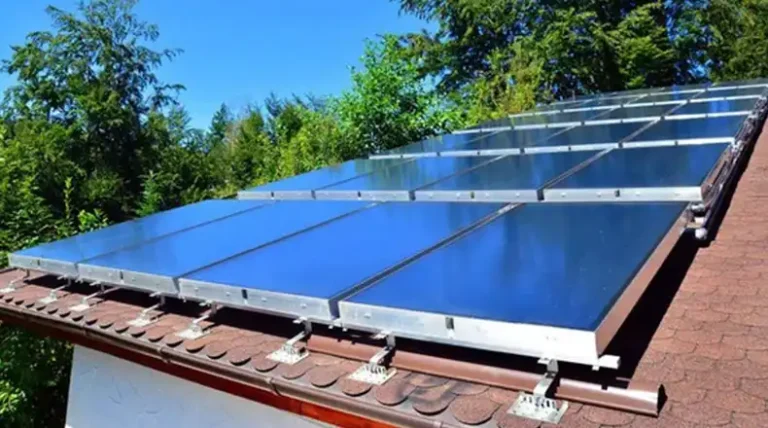Difference Between a MPPT vs PWM Solar Controller
Solar energy is a powerful source of renewable energy, and harnessing it efficiently requires the right technology. In this comprehensive guide, we will delve into the differences between PWM (Pulse Width Modulation) and MPPT (Maximum Power Point Tracking) solar charge controllers.
Buckle up as we explore beyond the conventional aspects of price and efficiency, diving into the depths of understanding to aid you in making an informed decision for your solar power system.
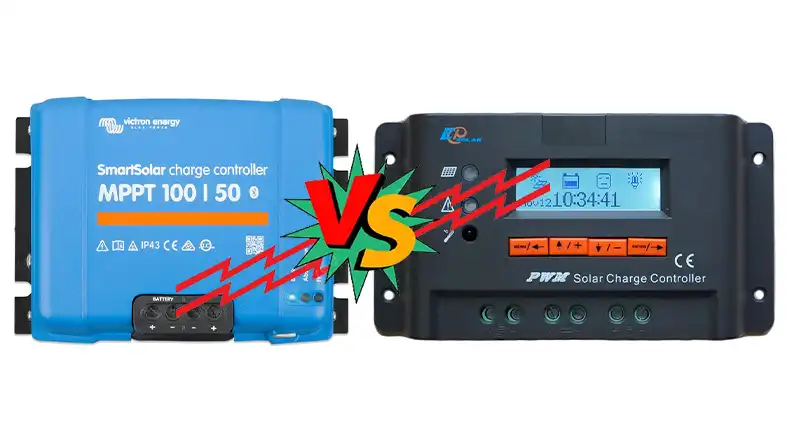
The Types of Solar Charge Controllers
When it comes to managing the flow of energy from your solar panels to your batteries, solar charge controllers play a pivotal role.
These devices ensure that your batteries receive the right amount of charge without overcharging or damaging them. Two primary types dominate the market: PWM and MPPT.
PWM (Pulse Width Modulation)
Pulse Width Modulation (PWM) technology is a stalwart in the world of solar charge controllers. Imagine it as a sophisticated switch that rapidly turns your solar panels on and off to achieve the desired output. This method effectively regulates voltage and protects your batteries from potential damage.
In simpler terms, PWM controllers modulate the duration of the electrical pulses sent to the batteries, maintaining a balance between charging efficiency and battery health. They’re reliable, cost-effective, and often the go-to choice for smaller solar power systems.
MPPT (Maximum Power Point Tracking)
On the other side of the spectrum, we have Maximum Power Point Tracking (MPPT) controllers. These devices take solar charge control to the next level by constantly tracking the maximum power point along the IV curve of your solar panels.
This dynamic tracking ensures optimal energy harvest, even in varying weather conditions.
In essence, MPPT controllers are the high-tech navigators of solar charge regulation. They identify the sweet spot where your solar panels produce the maximum power and adjust the voltage accordingly for efficient battery charging.
While MPPT controllers boast higher efficiency, they come at a higher cost, making them ideal for larger solar arrays.
What PWM Solar Charge Controllers Are
When it comes to solar charge controllers, PWM (Pulse Width Modulation) controllers have long been the reliable workhorse of the solar energy world. Let’s dissect the pros and cons of PWM solar charge controllers and explore where they shine the brightest.
Pros and Cons
Pros of PWM Solar Charge Controllers
Affordability at the Forefront
One of the standout advantages of PWM controllers is their cost-effectiveness. These controllers are generally more budget-friendly compared to their MPPT counterparts, making them an attractive option for those looking to keep initial expenses in check.
Simplicity in Small Systems
For small-scale solar power setups, PWM controllers shine. They’re straightforward to set up and are ideal for applications where the solar array is relatively modest, typically in the range of 300-400 watts or less.
Robust and Reliable
PWM controllers boast a robust design, making them durable and reliable. They have proven their mettle in various applications, providing a stable and consistent performance over time.
Cons of PWM Solar Charge Controllers
Efficiency Trade-off
While PWM controllers get the job done, their efficiency falls short when compared to MPPT controllers. Typically operating at around 75% conversion efficiency, they may not be the go-to choice for those aiming to maximize every bit of energy from their solar panels.
Limited Voltage and Current Handling
PWM controllers come with limitations in terms of the maximum voltage and current they can handle. This makes them less suitable for larger solar arrays where higher limits are essential for optimal performance.
Feature Set Constraints
When it comes to additional features, PWM controllers often lag behind MPPT controllers. If you’re seeking advanced functionalities such as Bluetooth connectivity or custom charging profiles, you might find PWM controllers lacking in this department.
Ideal Applications
PWM controllers find their sweet spot in smaller solar setups, particularly those generating 300-400 watts or less. Their simplicity and cost-effectiveness make them a practical choice for residential or small-scale applications.
PWM controllers operate efficiently when the photovoltaic (PV) panel voltage closely matches the battery voltage. In situations where this alignment is feasible, PWM controllers can be a suitable and economical choice.
What MPPT Solar Charge Controllers Are
Solar energy has become a cornerstone of sustainable power solutions, and the choice of solar charge controllers plays a pivotal role in optimizing energy harnessing. We’ll dissect the intricacies of MPPT (Maximum Power Point Tracking) solar charge controllers, exploring their advantages, drawbacks, and the ideal scenarios where they shine.
Pros and Cons
Pros of MPPT Solar Charge Controllers
MPPT solar charge controllers boast a set of compelling advantages that make them a preferred choice for many solar enthusiasts:
- Efficiency Marvel: The standout feature of MPPT controllers is their remarkable efficiency, typically hovering around 95%. This means they excel at converting solar power into usable electricity, maximizing the energy harvested from your solar panels.
- Higher Current and PV Voltage Limits: MPPT controllers offer greater flexibility by accommodating higher current and photovoltaic (PV) voltage limits. This versatility makes them suitable for a wide range of solar power system configurations.
- Abundance of Features: Beyond basic functionality, MPPT controllers often come loaded with additional features. From Bluetooth connectivity for remote monitoring to the ability to create custom charging profiles, these controllers offer a sophisticated suite of options.
- Top-Notch Build Quality: In the realm of durability, MPPT controllers tend to shine. Their construction is usually of superior quality, ensuring longevity and reliability in diverse environmental conditions.
Cons of MPPT Solar Charge Controllers
While MPPT controllers exhibit impressive strengths, it’s essential to be aware of their limitations:
- Cost Considerations: The efficiency and advanced features of MPPT controllers come at a price. They are generally more expensive than their PWM counterparts, making them a substantial investment upfront.
- Overkill for Small Systems: MPPT controllers might be overkill for smaller solar power systems, especially those generating 300-400 watts or less. The complexity and cost may outweigh the benefits in such scenarios.
Best Use Cases
Choosing the right solar charge controller involves aligning its strengths with your specific needs. Here are the best use cases for MPPT controllers:
- Larger Solar Power Systems (>400W): MPPT controllers truly shine in larger solar arrays, where their efficiency and higher voltage limits come into play. For systems exceeding 400 watts, MPPT is often the superior choice.
- Limited Mounting Space: When you face constraints in mounting space, the efficiency gains of MPPT controllers become invaluable. Their ability to extract maximum energy from a limited space makes them ideal for installations with restricted real estate.
- Prioritizing Conversion Efficiency: If achieving the highest possible conversion efficiency is a top priority for your solar power system, then MPPT controllers are the go-to option. They excel in optimizing power production.
Face-off: MPPT vs PWM
In the realm of solar charge controllers, the decision between Maximum Power Point Tracking (MPPT) and Pulse Width Modulation (PWM) can be likened to choosing the right engine for your solar power system.
In this face-off, we’ll dissect the critical aspects – Efficiency, Cost, and Installation – to guide you in making an informed choice for harnessing the power of the sun.
Efficiency Showdown
When it comes to squeezing every bit of energy from your solar panels, efficiency takes center stage in the MPPT vs PWM showdown.
Unveiling Real-world Performance Metrics
Let’s cut through the technical jargon and delve into the real-world performance of MPPT and PWM controllers.
Picture this, your solar panels working tirelessly under various conditions. Which controller emerges as the champion in energy harvesting? We’ll explore the numbers and unveil the efficiency gains that can make a tangible impact on your power output.
Energy Harvesting Comparisons
Comparing the efficiency of MPPT and PWM controllers is not just about numbers; it’s about the energy harvested.
We’ll quantify the gains, providing you with a clear understanding of how each controller performs under different scenarios. Get ready for a deep dive into the nitty-gritty of energy conversion and its implications on your solar power system.
Cost Considerations
Efficiency is crucial, but so is your budget. Let’s dissect the cost aspects of MPPT and PWM controllers, revealing the financial landscape of these technologies.
Initial Investment vs. Long-term Savings
They say you have to spend money to make money. In the solar controller arena, MPPT comes with a higher initial price tag, but does it pay off in the long run? We’ll unravel the financial dynamics, helping you see beyond the sticker price and understand how each controller affects your bottom line.
Balancing Performance and Budget
Striking the perfect balance between performance and budget is an art. We’ll guide you through the decision-making process, offering insights into why PWM controllers might be the economical choice in certain scenarios and how MPPT controllers can be a wise investment for the future.
Installation and Maintenance
Efficiency and cost are essential, but what about the nitty-gritty of setting up and maintaining your solar power system? Let’s explore the installation and maintenance aspects of MPPT and PWM controllers.
Ease of Set-Up
Setting up your solar charge controller shouldn’t feel like deciphering a complex code. We’ll break down the ease of installation for both MPPT and PWM controllers, providing you with a clear roadmap for getting your system up and running.
Whether you’re a seasoned DIY enthusiast or a first-time solar adventurer, we’ve got you covered.
Long-Term Reliability
In the world of solar power, reliability is non-negotiable. We’ll delve into the long-term reliability of MPPT and PWM controllers, shedding light on factors that contribute to the longevity of your solar power system.
From robust build quality to resistance against environmental challenges, we’ll guide you on making a choice that stands the test of time.
What Are The Decision-Making Factors
When venturing into the realm of solar energy, the decision between Maximum Power Point Tracking (MPPT) and Pulse Width Modulation (PWM) charge controllers becomes crucial.
In this segment, we unravel the key decision-making factors that will guide you in choosing the right controller for your solar power system.
System Size and Complexity
Determining the optimal charge controller hinges on the size and complexity of your solar power setup. For smaller systems, where efficiency gains might be outweighed by cost considerations, a PWM controller could be the pragmatic choice.
PWM controllers, cost-effective and straightforward, prove ideal for systems generating 300-400 watts or less.
Conversely, as your solar array expands beyond the 400-watt threshold, the sophistication of an MPPT controller comes into play.
Its ability to adapt to larger systems, coupled with higher current and voltage ratings, positions MPPT controllers as the preferred choice for complex setups demanding optimal performance.
Strike a balance between your system’s size, current requirements, and the future scalability you may envision. A thoughtful consideration of these factors ensures that your charge controller aligns seamlessly with the unique demands of your solar power infrastructure.
Geographic and Environmental Factors
The geographic location and environmental conditions in which your solar power system operates exert a significant influence on the choice between MPPT and PWM controllers.
In regions with subtropical to tropical climates, where consistent sunlight prevails, both MPPT and PWM controllers perform admirably. However, the picture changes when considering the impact of extreme temperatures.
MPPT controllers demonstrate resilience in cold to temperate climates, making them the preferred choice when environmental conditions veer towards the extreme ends of the spectrum.
Additionally, the physical location of your solar panels plays a role. In environments prone to mixed light conditions, the wiring configuration becomes a critical consideration. Here, PWM controllers, with their parallel wiring setup, can offer advantages.
Navigate the decision-making process by assessing the climate nuances and the exposure of your solar panels to diverse environmental elements.
This thoughtful evaluation ensures that your chosen charge controller adapts seamlessly to the geographical and environmental factors shaping your solar energy venture.
What Are The Future Trends in Solar Charge Control
As we ride the renewable energy wave, the future of solar charge controllers is shaping up with exciting advancements. In this segment, we’ll explore the upcoming trends in solar charge control that are set to redefine how we harness energy from the sun.
Technological Innovations
In the fast-evolving realm of solar charge controllers, technological innovations are propelling us toward more efficient and sophisticated systems.
Manufacturers are investing in research and development to enhance the capabilities of both MPPT (Maximum Power Point Tracking) and PWM (Pulse Width Modulation) controllers.
These innovations aim to improve conversion efficiencies, making the most out of every ray of sunlight. Expect smarter algorithms and advanced tracking mechanisms that adapt to varying conditions, ensuring optimal energy harvest even in challenging environments.
The future holds promise for charge controllers that are not just efficient but also intelligent in maximizing power output.
Imagine a solar charge controller that can dynamically adjust its settings based on real-time data, optimizing performance for different weather patterns and sunlight intensities. This isn’t science fiction; it’s the direction in which solar charge controller technology is heading.
Emerging Integration
Solar charge controllers are no longer standalone components in a solar power system. The future envisions seamless integration with cutting-edge technologies, opening up new possibilities for energy management and control.
Smart Grids and IoT
The synergy between solar charge controllers and smart grids is one of the most exciting developments on the horizon. Imagine a solar power system that communicates intelligently with the grid, adjusting its operation based on grid demand and supply.
This two-way interaction ensures efficient energy distribution and contributes to the stability of the broader electrical network.
Internet of Things (IoT) integration takes solar charge controllers to the next level. Picture a solar power system equipped with sensors and communication devices, providing real-time data on energy production, consumption, and system health.
This interconnectedness allows users to monitor and manage their solar power systems remotely, enhancing control and convenience.
Integration with Energy Storage Systems
As energy storage solutions become more prevalent, the integration of solar charge controllers with these systems becomes imperative. The future will see charge controllers that seamlessly work with advanced energy storage technologies, such as lithium-ion batteries.
This integration not only facilitates efficient energy storage but also enables intelligent charging and discharging cycles.
Imagine a solar power system that optimally utilizes stored energy based on consumption patterns and grid demands. The result is a more reliable and resilient solar power solution that adapts to the dynamic needs of users.
Frequently Asked Questions
Q1: What is the primary difference between MPPT and PWM solar charge controllers?
A1: The key difference lies in their charging mechanisms. MPPT (Maximum Power Point Tracking) controllers dynamically adjust voltage and current to optimize energy harvest, while PWM (Pulse Width Modulation) controllers regulate output by rapidly switching the solar panel on and off.
Q2: Which is more cost-effective, MPPT, or PWM?
A2: PWM controllers are generally more budget-friendly upfront, but MPPT controllers offer higher efficiency, potentially leading to long-term savings. The choice depends on your budget and the specific needs of your solar power system.
Q3: What are the ideal applications for PWM controllers?
A3: PWM controllers are well-suited for small to medium-sized solar power systems, typically up to 400 watts. They are cost-effective and can efficiently handle scenarios where the PV voltage is close to the battery voltage.
Q4: When should I consider using an MPPT controller?
A4: MPPT controllers excel in larger solar arrays (above 400 watts), situations where mounting space is limited, and when conversion efficiency is a top priority. They are also preferred for scenarios involving series connecting solar panels.
Q5: How do I determine the size of the charge controller I need?
A5: Consider the size and complexity of your solar power system. For smaller setups, a PWM controller may suffice, while larger arrays with varying conditions may benefit from the efficiency gains of an MPPT controller. Utilize a charge controller calculator for precise sizing.
Q6: Are there geographical considerations when choosing between MPPT and PWM?
A6: Yes, environmental factors play a role. PWM controllers perform well in subtropical to tropical climates, while MPPT controllers tend to outperform in cold to temperate climates. Consider your location and climate conditions when making a decision.
Q7: What are the emerging trends in solar charge control technology?
A7: The future holds exciting technological innovations, such as smarter algorithms, advanced tracking mechanisms, and integration with smart grids and IoT. Expect solar charge controllers to become more efficient, intelligent, and seamlessly integrated with energy storage systems.
Q8: Can I connect multiple solar panels in series with both MPPT and PWM controllers?
A8: MPPT controllers generally have higher PV voltage limits, allowing for series connections. PWM controllers may require parallel wiring, increasing current and potential equipment costs. Check the specifications of your specific controller for guidance.
Q9: How does PV voltage vs. battery voltage impact the choice between MPPT and PWM?
A9: PWM controllers work best when PV voltage is close to the battery voltage, while MPPT controllers operate efficiently regardless of the voltage difference. Consider your system setup and whether you require flexibility in matching different voltage levels.
Q10: What are the benefits of integrating solar charge controllers with energy storage systems?
A10: Integration with energy storage systems enhances the overall reliability and efficiency of solar power systems. It allows for optimized charging and discharging cycles, adapting to consumption patterns and grid demands for a more resilient energy solution.
Conclusion
Summarize the key takeaways from the extensive exploration of MPPT and PWM charge controllers. Provide a concise recap of the factors to consider when making a decision for your solar power system.
Conclude with a message of empowerment, encouraging readers to make informed choices that align with their specific needs and goals. Inspire confidence in navigating the dynamic landscape of solar charge controllers.

